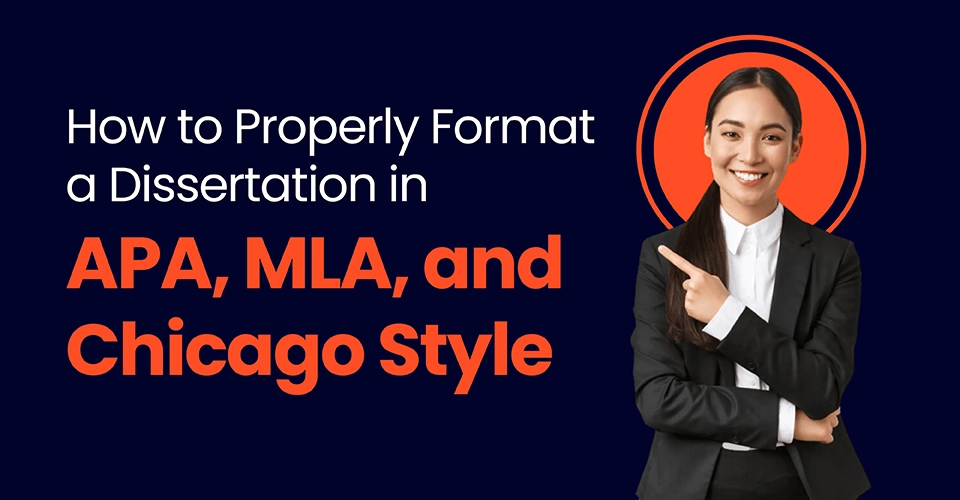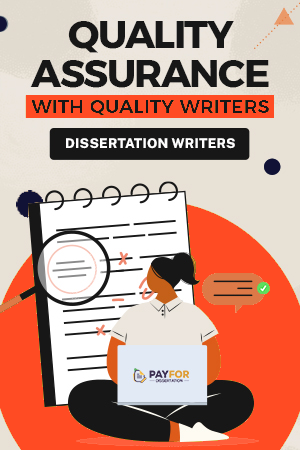
How to Properly Format a Dissertation in APA, MLA, and Chicago Style
One often overlooked part of academic writing is formatting a dissertation but it is equally important as any of those. Nevertheless, formatting correctly from the start helps to save time and to satisfy institutional guidelines. Whether you're working in the social sciences, humanities, or history, selecting the right citation style—APA, MLA, or Chicago—is essential for presenting your work professionally and maintaining academic credibility.
All of these styles have different sets of rules for title pages, in-text citations, and reference lists, made spacing also. Students are responsible for applying the right guidelines specified by the discipline and universities normally specify which style to use in a discipline, but some guidelines are to be followed by universities generally; some students are less strong on these points, otherwise, they have to pay attention to those guidelines in their dissertation. This blog provides a detailed overview of APA, MLA, and Chicago styles, helping you understand their differences and offering practical guidance on how to format your dissertation properly.
Understanding APA Dissertation Format Guidelines
The use of APA style is common in social sciences, psychology, education, and related fields. Bearing this in mind, you are required to use APA formatting to present research findings in a clear consistent, and structured manner.
Title Page and Abstract Formatting
In APA style, your dissertation title page contains your title, your name, institutional affiliation, course name, instructor, and date of submission supplied and centered. The abstract details on the next page as it only involves about 150 to 250 words and is briefly presented in summary form. The abstract should be put in one single paragraph without indentation and should be written in one paragraph.
Citation Rules and Reference Lists
APA follows an author-date system of citing. Your dissertation reference list is finished off with the reference list appearing at the end, with full citations for every source you mention in the text of your dissertation. The format of each entry is Author(s). (Year). Title in italics. Publisher. Entries should be alphabetized and hanging indents should be used.
In-text Citations for APA, MLA, and Chicago
In-text citation indicates the author’s last name and the year of publication in APA style (Smith, 2022). Of course, for direct quotes, add the page number: (Smith, 2022, p. 45). The flow of text is smooth and easy to follow so that the citation format can be made.
MLA Style Rules for Dissertation Formatting
The Modern Language Association (MLA) style is widely used in the humanities, especially in literature, philosophy, and the arts. It is well known to be simple and to rely heavily upon the author's voice.
Margins, Fonts, and Spacing Requirements
MLA style requires one-inch margins on all sides and recommends using a readable font like Times New Roman, size 12. All the dissertation, including the works cited page, needs to be double-spaced. There also should be a one-half-inch indentation from the fore-edge margin for each new paragraph.
Title Page and Abstract Formatting
Unlike APA and Chicago, MLA does not mandate a separate title page unless specifically requested. The first page only lists on the left, in the middle, the title, your name, the instructor’s name, the course, and the date. The abstract is optional in MLA but, if included, should follow MLA's double-spacing and font rules.
Citation Rules and Reference Lists
MLA uses the author-page citation format. For example: (Shakespeare 23). The unindent: Author’s Last Name and First Name, makes the list of sources alphabetized with no indenting. Title of Book. Publisher, Year.
For the students of the humanities, this is a particularly good style for citing source pages and primary texts.
Formatting a Dissertation Using Chicago Style
History, many businesses, and some parts of the arts depend on the Chicago Manual of Style. It contains the Notes and Bibliography system and the Author-Date system in its documentation.
In-text Citations for APA, MLA, and Chicago
Notes and Bibliography are used by Chicago, so they require footnotes or endnotes rather than parenthetical notes. Citation appears in the corresponding note and a superscript number is placed at the end of the quote or sentence. For instance, “Economic reform was very important in this period.”¹
This is the APA-like system where the Authors are author chosen and dates are associated with entries, in-text citations look like (Smith 2021, 15) and the reference list is at the end. It should be applied consistently in each system whichever system is used in the dissertation.
Citation Rules and Reference Lists
According to this format, footnotes in the Notes and Bibliography system come after this.
From Understanding Historical Trends (New York: Academic Press, 2021), 44 (John Smith)
Entries at the end of the bibliography are hung indented according to the author’s last name.
It is the Chicago style that is particularly valuable for dissertations that include a wide variety of source types, such as archival materials and multimedia content because it is flexible.
Margins, Fonts, and Spacing Requirements
Like APA and MLA, the Chicago style requires one-inch margins and a 12-point readable font, such as Times New Roman. All quotations and references should be double-spaced; the text needs to be double-spaced. The footnote should be singled spaced with a double spacer between entries.
In cases where formatting becomes complex or you’re unsure how to structure your dissertation properly, many students opt to pay for dissertation formatting assistance or consult university writing centers. When dealing with many different style guidelines or complicated source material, expert help can guarantee adherence to all academic guidelines.
Key Differences Between APA, MLA, and Chicago Styles
Even though all three formatting styles are trying to standardize how academic writing should be presented, they handle the citations, structure, and formatting in different ways.
Title Page and Abstract Formatting
- An abstract and a title page are required by APA.
- MLA does not require a title page or abstract unless specified.
- An abstract may be included and a title page is needed as per usual.
In-text Citations for APA, MLA, and Chicago
- APA uses author-date citations.
- MLA uses author-page format.
- Notes and Bibliography use footnotes, while Author-Date is similar to APA.
This is important because they are the differences you need to understand to conform your dissertation’s formatting consistently and avoid formatting penalties from academic reviewers.
Citation Rules and Reference Lists
There are different rules for citing books, journal articles, etc. each style.
- The year is put early in an APA entry.
- MLA emphasizes page numbers.
- The best footnotes and bibliographies are presented in Chicago.
Application of these rules will go a long way in making your dissertation more academic in tone and make it appear more credible.
Common Formatting Mistakes to Avoid in Dissertation Writing
Formatting errors can kill the credibility of the most researched dissertation. One of the most frequent mistakes students make is inconsistency—mixing elements from different citation styles, such as using APA in-text citations but formatting the reference list in MLA style. It creates confusion not just in the pace of reading but also in the setting of points deductions.
One of the most common bugs is managing headings and subheadings hypocritically. Different levels of headings are formatted differently in each citation style, and if you do not follow the rules in this, your structure can become unclear. One of the most common errors during the transition between software platforms like Google Docs and Microsoft Word is spacing errors: inconsistent line spacing or incorrect paragraph indentation.
Additionally, incorrect citation formatting such as missing page numbers, that are not italicized when the title needs to be, or wrong addresses or full bibliographies can lead to a reduction of your academic integrity. These elements should of course be checked against official style guides or university templates.
Finally, proofreading is never to be underestimated. Even a simple formatting error may be miniscule, but in a formal academic setting that can seriously damage your overall grade. By getting the time to source and review or to respond to formatting experts, you can be sure your dissertation reaches the highest academic standards.
Conclusion
As well as a factor of correctness, formatting your dissertation will indicate that you took it seriously enough to do it well, and accordingly will do your dissertation well. Whether you’re using APA, MLA, or Chicago style, understanding the specific guidelines for each citation format can help you produce a polished and professional document.
There isn’t just one form of paragraphing that is typical across all subjects and disciplines, therefore, you are basically up to your tastes and your field of study as well as your university guidelines on what is appropriate. APA offers clarity and structure for empirical studies, MLA is ideal for humanities and literary analysis, and Chicago provides flexibility for historical and interdisciplinary work.
If you prefer, don’t be afraid to use services provided by experts, or if you are in dire straits with formatting, referencing, or citation rules, do not hesitate to solicit help from writing centers. The fact is, they are worthless if your formatting is bad, even if it looks perfect. Formatting is the key differentiator because it makes your work appear to be taken seriously by academic reviewers and contributes to your field of research.
